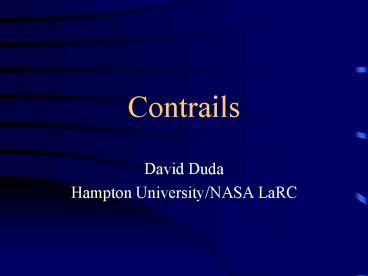Contrails - PowerPoint PPT Presentation
1 / 21
Title:
Contrails
Description:
Contrails are CLOUDS that form in the wake of aircraft. Contrail is a shortened name ... Air traffic and persistent contrail coverage will continue to increase. ... – PowerPoint PPT presentation
Number of Views:251
Avg rating:3.0/5.0
Title: Contrails
1
Contrails
- David Duda
- Hampton University/NASA LaRC
2
Outline
- Introduction What are contrails?
- Making a cloud (how contrails form)
- Why do we study contrails?
- SCOOL and contrails
- Contrail cousins
3
Introduction
- Contrails are CLOUDS that form in the wake of
aircraft. - Contrail is a shortened name for condensation
trails. - Also known as vapor trails, jet trails,
chemtrails
4
Contrails have been around for a long time!
- They were first described in the scientific
literature in 1919. - During WWII, contrails sometimes littered the
skies during aerial combat.
5
Making A Cloud
Clouds form when water vapor in the air condenses
into visible water droplets or ice crystals.
- Condensation can occur in two ways
- Increase the water content in the air.
- Cool the air to reach the dew point.
6
Making A Cloud (Part 2)
Nearly all contrails form by the mixing of the
colder, drier atmosphere with the warmer, wetter
jet exhaust (mixing cloud).
7
Mixing clouds
- Mixing clouds form because the ability of air to
hold water vapor increases rapidly with
temperature. - Like contrails, the cloud that forms on your
breath during a cold day is a mixing cloud.
8
Nearly all contrails are mixing clouds
Most contrails that you see in the sky form at
high altitudes (above 26,000 ft) and at very cold
temperatures (less than -40?F).
9
Why Do We Study Contrails?
Contrails cause detection and visibility problems
for military aircraft.
10
When the upper atmosphere is moist enough, the
contrails continue to grow. Under
these conditions, the contrails
become persistent.
11
Persistent contrails occasionally cover large
areas. Like cirrus clouds, contrails likely
contribute to global warming.
We currently estimate that contrails add an
additional 0.5 to 5 percent warming to the
greenhouse gas effect.
12
Air traffic and persistent contrail coverage will
continue to increase.
13
By 2050, the warming due to contrails may be
2.5 to 25 percent of the current greenhouse gas
warming.
14
SCOOL and Contrails
15
Our estimates of the climatic effects of
persistent contrails are still uncertain. We
still have trouble estimating contrail coverage.
16
Most contrails are still smaller than the
resolution of most satellites.
17
Using inventories of commercial aircraft flight
data and satellite data, we are learning more
about the growth and coverage of contrails under
different atmospheric conditions. Surface
observations from SCOOL would improve our
studies.
18
Contrail Cousins
19
Unconventional Contrails(clouds, but not mixing
clouds)
20
Contrails (not!)
This B-52 is producing smoke!
Skywriting planes also produce smoke. Often the
smoke is from a type of cooking oil!
21
Inverse contrails (distrails)
Aircraft sometimes make holes in clouds!































